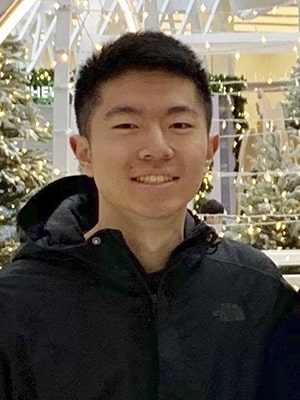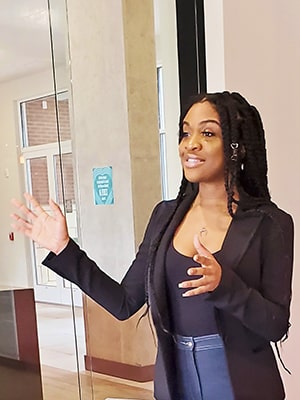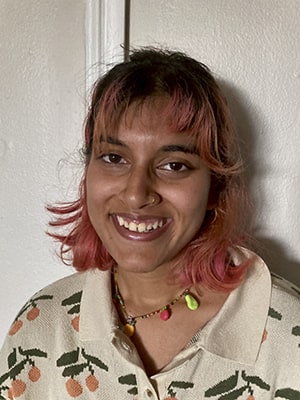A Partnership for the Goals
By Michael Henninger
Media Inquiries- University Communications & Marketing
- 412-268-2902
Carnegie Mellon released today its second Voluntary University Review of how the university's education, research and practice align with the Sustainable Development Goals. This year, an interdisciplinary student trio proved instrumental in several new and emerging ways to communicate CMU's efforts at creating a sustainable future.
Student interns Bobuchi Ken-Opurum, Khushi Nandgaonkar and Peter Wu put varying skillsets to work, and through their partnership — which is incidentally goal 17 — created new tools to map and display how classes and initiatives across CMU are related to the 17 Sustainable Development Goals (the SDGs or the Global Goals).
Last year, Carnegie Mellon completed a first-of-its kind Voluntary University Review benchmarking its efforts in adopting the United Nation's approach. The initial version, of what will be an annual report at CMU, was enlightening but suggested that an ongoing and interactive process would provide more valuable information.
"Using the framework of the goals, we want to help members of the CMU community make more informed choices about their classes and research activities, and to see how the university's activities are contributing to this ambitious global agenda," said Alexandra Hiniker, executive fellow for Sustainability Initiatives. "These talented students — Bobuchi, Khushi and Peter — are central to creating new ways to engage with sustainability at CMU."
Learn about the Sustainable Development Goals at CMU and how to get involved.
With the new beta-version tool, students can map the SDGs to classes and schools across CMU. A student interested in finding courses pertaining to a particular goal — say, goal 5 on gender equality — can sort the course catalogue and discover classes of interest.
 Wu (left), a senior studying math in the Mellon College of Science, designed the functionality that maps the SDGs to CMU courses.
Wu (left), a senior studying math in the Mellon College of Science, designed the functionality that maps the SDGs to CMU courses.
"My goal was to come up with a systematic, objective and repeatable methodology to map text to the goals," Wu said. "We generated a list of keywords for each SDG and extracted those words from every course description to quantify the alignment of SDGs to CMU curriculum."
This beta-version analysis tool and the list of keywords are open source and can be used by anyone looking at any dataset, including other universities tracking their educational efforts on the SDGs.
Results of the mappings are also displayed in interactive tableaus on the Sustainability Initiative web pages. In addition to courses, users can explore how CMU's activities are contributing to the Global Goals.
 Before the new resources went live on CMU's sustainability website, Ken-Opurum (right), a Ph.D. candidate in architecture-engineering-construction management (AECM), reached out to a sampling of CMU faculty to research how well the SDG mapping worked.
Before the new resources went live on CMU's sustainability website, Ken-Opurum (right), a Ph.D. candidate in architecture-engineering-construction management (AECM), reached out to a sampling of CMU faculty to research how well the SDG mapping worked.
"The benchmarking of the goals is important for transparency and accountability," said Ken-Opurum. "We can have these conversations about sustainability at CMU and use this new data to really dig in to where we're succeeding and where we can do more."
With positive initial results, Wu's work is now online, but that's not the end of the feedback cycle. Hiniker hopes that faculty members will find their courses and comment on the mapping to refine the process.
"We want everyone to take a look, and tell us what works and what doesn't, so we can continue to improve upon it," Hiniker said.
 The final part of the equation came from Nandgaonkar (left), a senior in the School of Art. The Sustainability Initiative had a new way to track sustainability at CMU but was looking for a way to let everyone know.
The final part of the equation came from Nandgaonkar (left), a senior in the School of Art. The Sustainability Initiative had a new way to track sustainability at CMU but was looking for a way to let everyone know.
Nandgaonkar put her talents to work designing a communications strategy (including creating the video above, which is narrated by 2021 College of Fine Arts alumnus Darius Fraser) for rolling out the new web pages and their functionalities.
"The SDGs can be a common language for how everyone here talks about sustainability," she said. "These goals are more holistic than just climate change. They bridge the gaps between environmental justice and social justice. I think it helps to map out how we all fit into the broad picture of sustainability."